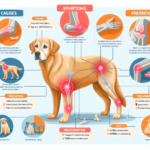English Setter Joint Pain: Causes, Symptoms, Prevention, and Treatment

Introduction
The English Setter is a graceful and elegant breed known for its hunting prowess and gentle demeanor. Originating in England, this breed has a rich history dating back to the 14th century, where it was primarily used for setting and retrieving game birds. English Setters are characterized by their distinctive feathered coat, which can be either flat or slightly wavy, and their friendly, affectionate nature. They are medium to large-sized dogs, typically weighing between 45 to 80 pounds, and are known for their endurance and agility.
Like many purebred dogs, English Setters are prone to certain health issues, including joint pain. Joint health is particularly crucial for this breed due to their active lifestyle and genetic predispositions. Ensuring the well-being of their joints can significantly enhance their quality of life and longevity.
Breed-Specific Joint Pain Risks
Genetic Predisposition
English Setters are genetically predisposed to several joint-related issues, including hip dysplasia, elbow dysplasia, and arthritis. Hip dysplasia is a condition where the hip joint does not fit into the hip socket properly, leading to pain and mobility issues. Elbow dysplasia involves abnormal development of the elbow joint, causing lameness and discomfort. Arthritis, a degenerative joint disease, is also common in this breed, particularly as they age.
Age-Related Risks
As English Setters age, the risk of developing joint pain increases. Typically, signs of joint issues may start to appear in middle age, around 5 to 7 years old. However, some dogs may show symptoms earlier, especially if they have a genetic predisposition. Senior English Setters, those over 8 years old, are particularly vulnerable to arthritis and other degenerative joint conditions.
Activity Level and Joint Stress
English Setters are known for their high energy levels and love for physical activities such as running, hunting, and playing. While regular exercise is essential for their overall health, excessive or high-impact activities can put stress on their joints, potentially leading to injuries or exacerbating existing conditions. Owners should be mindful of balancing their dog’s activity levels to prevent undue joint stress.
Common Symptoms of Joint Pain in English Setters
General Symptoms
- Limping or favoring one leg
- Stiffness, especially after rest or sleep
- Reluctance to climb stairs or jump
- Decreased activity or playfulness
- Visible discomfort or pain when moving
- Swelling around the joints
Breed-Specific Symptoms
In English Setters, joint pain may manifest more prominently in their hips and elbows due to their predisposition to hip and elbow dysplasia. Owners may notice a “bunny hopping” gait, where the dog uses both hind legs together when running, or a noticeable decrease in their ability to perform tasks they previously enjoyed, such as retrieving or running long distances.
When to Consult a Vet
If an English Setter exhibits any of the above symptoms persistently, it is crucial to consult a veterinarian. Early diagnosis and intervention can prevent further deterioration and improve the dog’s quality of life. Regular veterinary check-ups are also essential for monitoring joint health, especially as the dog ages.
Preventive Measures for Joint Health
Exercise Recommendations
Regular, moderate exercise is vital for maintaining joint health in English Setters. Activities such as walking, swimming, and controlled play can help keep their joints flexible and muscles strong without causing excessive stress. Avoid high-impact activities like jumping or running on hard surfaces, which can exacerbate joint issues.
Dietary Suggestions
A balanced diet rich in essential nutrients can support joint health. Foods containing glucosamine, chondroitin, and omega-3 fatty acids are particularly beneficial. These nutrients help maintain cartilage health and reduce inflammation. Owners may also consider joint supplements, but it is advisable to consult a veterinarian before adding any supplements to the dog’s diet.
Weight Management
Maintaining a healthy weight is crucial for reducing joint stress. Overweight dogs are more prone to joint issues due to the additional strain on their joints. Owners should monitor their English Setter’s weight and adjust their diet and exercise routine accordingly to prevent obesity.
Early Screening and Monitoring
Regular veterinary check-ups and early screening for joint issues can help catch problems before they become severe. For English Setters, screening for hip and elbow dysplasia is recommended, especially if there is a family history of these conditions. Early intervention can significantly improve outcomes and quality of life.
Treatment Options for Joint Pain
Non-Surgical Treatments
Non-surgical treatments for joint pain in English Setters include medications, physical therapy, and lifestyle adjustments. Anti-inflammatory drugs and pain relievers can help manage symptoms, while physical therapy can improve mobility and strengthen muscles around the joints. Lifestyle adjustments, such as providing a comfortable bed and avoiding high-impact activities, can also alleviate pain.
Surgical Options
In severe cases, surgical intervention may be necessary. Common surgeries for joint issues in English Setters include hip replacement, elbow arthroscopy, and joint fusion. These procedures can significantly improve mobility and reduce pain, but they come with risks and require a thorough discussion with a veterinarian.
Alternative Therapies
Alternative treatments such as acupuncture, hydrotherapy, and massage can also benefit English Setters with joint pain. Acupuncture can help reduce pain and inflammation, while hydrotherapy provides low-impact exercise that strengthens muscles without stressing the joints. Massage can improve circulation and reduce muscle tension around the affected joints.
Lifestyle and Management Tips
Daily Care Routine
A daily care routine for an English Setter with joint pain should include gentle exercise, a balanced diet, and regular monitoring of their condition. Short, frequent walks and swimming sessions can keep them active without causing excessive joint stress. Providing a comfortable, supportive bed and avoiding slippery surfaces can also help manage their pain.
Modifying the Home Environment
Making the home environment more comfortable for a dog with joint pain can significantly improve their quality of life. Consider using ramps instead of stairs, providing orthopedic beds, and ensuring that food and water bowls are at a comfortable height. Non-slip mats can also prevent falls and reduce joint strain.
Long-Term Management
Long-term management of joint pain in English Setters involves regular veterinary check-ups, consistent exercise, and a balanced diet. Owners should also be vigilant about monitoring their dog’s condition and making necessary adjustments to their care routine. With proper management, English Setters can lead active and happy lives despite joint pain.
FAQs About English Setters and Joint Pain
What are the early signs of joint pain in English Setters?
Early signs of joint pain in English Setters include limping, stiffness, reluctance to move, and decreased activity levels. Owners may also notice swelling around the joints and visible discomfort when the dog is moving.
Can joint pain in English Setters be prevented?
While genetic predispositions cannot be entirely prevented, joint pain in English Setters can be managed and minimized through regular exercise, a balanced diet, weight management, and early screening for joint issues.
Are there specific exercises that are better for English Setters with joint pain?
Low-impact exercises such as walking, swimming, and controlled play are ideal for English Setters with joint pain. These activities help maintain joint flexibility and muscle strength without causing excessive stress.
What dietary supplements can help with joint health in English Setters?
Supplements containing glucosamine, chondroitin, and omega-3 fatty acids can support joint health in English Setters. These nutrients help maintain cartilage health and reduce inflammation. Always consult a veterinarian before adding supplements to your dog’s diet.
When should I consult a vet about my English Setter’s joint pain?
If your English Setter shows persistent signs of joint pain, such as limping, stiffness, or reluctance to move, it is essential to consult a veterinarian. Early diagnosis and intervention can prevent further deterioration and improve your dog’s quality of life.
Conclusion
Joint pain is a common issue in English Setters, but with proper care and management, it can be effectively managed. Regular exercise, a balanced diet, weight management, and early screening are crucial for maintaining joint health. If your English Setter shows signs of joint pain, consult a veterinarian for appropriate diagnosis and treatment. By taking preventive measures and providing the necessary care, you can ensure your English Setter leads a happy and active life.




